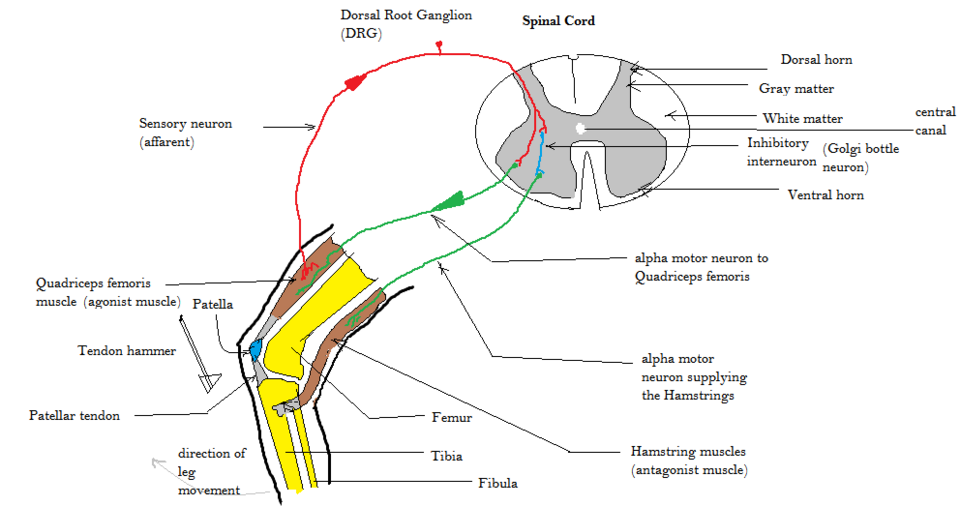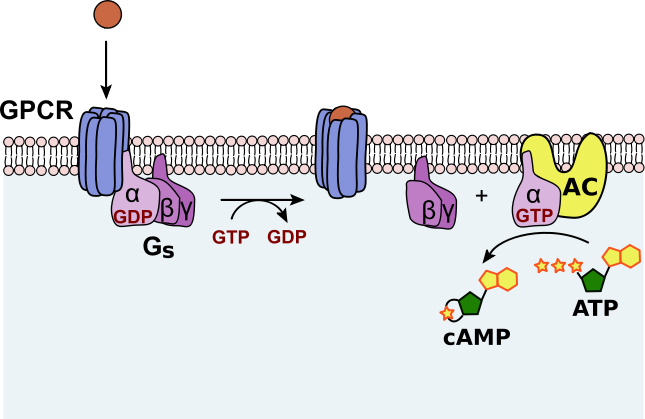OCR Specification focus:
‘Explain knee jerk reflex and survival value; coordinate responses via nervous and endocrine systems, including adrenaline, adenylyl cyclase activation and cyclic AMP as a second messenger.’
Organisms rely on rapid nervous and slower hormonal coordination to maintain survival and homeostasis. Reflexes, nerve pathways, and second messengers together enable swift, adaptive, and integrated biological responses.
Reflex Actions and Their Survival Value
The Role of Reflexes
A reflex action is an automatic, rapid, and involuntary response to a stimulus, designed to protect the body from harm or to maintain posture and balance without conscious control.
Reflex arc: The neural pathway that mediates a reflex action, typically involving a receptor, sensory neurone, relay neurone, motor neurone, and effector.
Reflexes are essential because they:
Bypass conscious thought, ensuring immediate responses to danger.
Minimise tissue damage, e.g. withdrawal reflex from a hot surface.
Maintain posture and balance, supporting coordinated movement.
Protect vital processes, such as breathing and blinking.
The Knee Jerk Reflex
The knee jerk reflex (patellar reflex) exemplifies a simple monosynaptic reflex arc — one sensory neurone synapses directly with one motor neurone, without an intermediate relay neurone.

Labelled schematic of the patellar tendon reflex showing muscle spindle activation, sensory and motor neurones, and quadriceps contraction. The diagram also depicts reciprocal inhibition of the hamstrings via an inhibitory interneurone, an extra detail beyond the OCR syllabus but helpful for full context. Source.
Process:
The patellar tendon is tapped, stretching the quadriceps muscle.
Stretch receptors (muscle spindles) detect this change and generate an action potential.
The sensory neurone transmits the impulse to the spinal cord.
It directly synapses with a motor neurone.
The motor neurone carries the impulse back to the quadriceps, causing contraction and leg extension.
This rapid contraction prevents the knee from buckling when standing — an example of postural reflex aiding balance and survival by maintaining upright stance.
Other Reflex Examples
Blink reflex: Protects eyes from foreign bodies and intense light.
Withdrawal reflex: Rapidly removes a limb from harmful stimuli (e.g. heat or sharp objects).
Corneal reflex: Prevents corneal damage by triggering eyelid closure.
Coordination Between Nervous and Endocrine Systems
Integration of Control
The body achieves coordination through two complementary systems:
The nervous system, which provides fast, electrical communication between neurones.
The endocrine system, which provides slower, chemical communication via hormones transported in the blood.
These systems interact to create an integrated response, particularly under stress or during ‘fight-or-flight’ reactions.
Coordination: The process by which different organs and systems of the body work together to produce a harmonious and appropriate response.
The Role of the Hypothalamus
The hypothalamus acts as the key link between the nervous and endocrine systems:
Detects changes in internal and external environments.
Sends nerve impulses to the sympathetic nervous system.
Stimulates the pituitary gland to release hormones that act on target organs such as the adrenal glands.
This dual control ensures that both immediate nervous responses and longer-term hormonal adjustments occur simultaneously.
The Adrenaline Response and Second Messengers
Adrenaline and the Fight-or-Flight Response
Adrenaline (epinephrine) is a hormone secreted by the adrenal medulla during stress, excitement, or danger. It coordinates several physiological responses to prepare the body for action.
Adrenaline effects include:
Increasing heart rate and stroke volume.
Dilating airways to improve oxygen uptake.
Stimulating glycogenolysis in the liver and muscles to release glucose.
Redirecting blood flow towards skeletal muscles.
Inhibiting non-essential processes like digestion.
These changes form the fight-or-flight response, essential for survival when facing acute threats.
Mechanism of Adrenaline Action: The Second Messenger System
Adrenaline acts via the second messenger model, which allows hormones that cannot cross the plasma membrane to trigger responses within target cells.
Step-by-step mechanism:
Adrenaline binds to specific G-protein-coupled receptors (GPCRs) on target cell membranes, such as liver cells.
The receptor activates the enzyme adenylyl cyclase within the cell membrane.
Adenylyl cyclase catalyses the conversion of ATP to cyclic AMP (cAMP) — the second messenger.

Diagram of hormone-activated GPCR signalling showing adrenaline binding, Gs activation, and adenylyl cyclase generating cAMP. It focuses on the OCR-required steps of the cAMP second messenger pathway, though receptor-specific details exceed syllabus depth. Source.
cAMP activates protein kinases, which phosphorylate target enzymes, amplifying the signal and leading to multiple cellular responses.
EQUATION
—-----------------------------------------------------------------
ATP → cAMP + PPi
ATP = Adenosine triphosphate (cellular energy source)
cAMP = Cyclic adenosine monophosphate (second messenger)
PPi = Inorganic pyrophosphate
—-----------------------------------------------------------------
Effects of cAMP Activation
The cAMP cascade amplifies the initial hormonal signal:
Activates enzymes such as glycogen phosphorylase, converting glycogen to glucose (glycogenolysis).
Inhibits enzymes that promote glycogen synthesis.
Increases cellular metabolic rate and ATP production.
This amplification means a single molecule of adrenaline can influence many intracellular reactions, providing rapid and efficient coordination of responses.
Significance of Second Messengers
Second messengers like cAMP allow small extracellular signals to produce large intracellular effects. This system ensures:
Signal amplification for efficiency.
Precise regulation through enzyme cascades.
Flexibility in response, as different cells may activate different downstream pathways depending on the receptor and kinase involved.
Second messenger: A small intracellular molecule that relays and amplifies signals received by receptors on the cell surface, triggering specific physiological responses.
Integration of Nervous and Hormonal Control in Coordination
Dual System Responses
Under stress, the sympathetic nervous system and endocrine system operate together:
The sympathetic nervous system releases noradrenaline from nerve endings to increase heart rate and blood pressure almost instantly.
The adrenal medulla releases adrenaline into the bloodstream for prolonged effects.
The parasympathetic nervous system later restores resting conditions — this is part of homeostatic balance.
These linked responses ensure rapid initial reactions followed by sustained physiological adjustments, illustrating the integration of both systems.
Importance in Biological Coordination
Enables precise, adaptive control of internal conditions during environmental changes.
Maintains homeostasis, ensuring cells function within optimal limits.
Provides hierarchical regulation, with the hypothalamus, pituitary, and adrenal glands forming an integrated control axis.
Demonstrates how reflexes, neural pathways, and second messengers contribute to the same goal — efficient coordination for survival.
FAQ
A monosynaptic reflex involves just one synapse between a sensory and a motor neurone, as seen in the knee jerk reflex. This allows for a rapid, automatic response.
A polysynaptic reflex includes one or more interneurones between sensory and motor neurones. This allows for more complex and coordinated responses, such as the withdrawal reflex, but takes slightly longer due to additional synapses.
Inhibitory neurones prevent opposing muscles from contracting during a reflex.
For example, during the knee jerk reflex, an inhibitory neurone in the spinal cord:
Receives impulses from the sensory neurone.
Sends inhibitory signals to the antagonistic (hamstring) motor neurone.
Ensures only the quadriceps contract, producing smooth, controlled leg extension.
This process is known as reciprocal inhibition, preventing conflicting muscle actions.
The autonomic nervous system (ANS) and hormones can modulate reflexes. Increased adrenaline or sympathetic activity heightens nervous system excitability, making reflexes faster or stronger.
In contrast, fatigue, alcohol, or sedatives reduce central nervous system responsiveness, slowing reflex actions.
Therefore, factors affecting synaptic transmission, neurotransmitter release, or receptor sensitivity can alter reflex performance.
Each molecule of cAMP can activate several protein kinases, and each kinase can phosphorylate multiple target enzymes.
This creates a cascade effect, where the initial signal (one hormone molecule binding to a receptor) results in hundreds or thousands of intracellular reactions.
The amplification ensures:
A rapid response even to low hormone concentrations.
Energy efficiency, as the hormone itself does not enter the cell.
This cascade principle is central to second messenger systems such as those involving adrenaline and glucagon.
Signal termination prevents overstimulation and restores normal cellular activity.
Key steps include:
Phosphodiesterase enzymes breaking down cAMP into inactive AMP.
G-proteins deactivating when GTP is hydrolysed to GDP.
Receptor desensitisation, where prolonged exposure causes receptor inactivation or internalisation.
These mechanisms ensure precise control of hormone signalling and maintain homeostasis within the cell.
Practice Questions
Question 1 (2 marks)
Describe the role of the reflex arc in maintaining posture using the knee jerk reflex as an example.
Mark scheme:
1 mark: Correctly identifies that the knee jerk reflex is a monosynaptic reflex arc involving a direct connection between sensory and motor neurones.
1 mark: Explains that it maintains posture and balance by causing contraction of the quadriceps when the tendon is stretched, preventing the knee from buckling.
Question 2 (5 marks)
Explain how adrenaline acts as a first messenger to trigger the production of cyclic AMP (cAMP) and how cAMP functions as a second messenger within target cells.
Mark scheme:
1 mark: States that adrenaline binds to specific receptors (G-protein-coupled receptors) on the cell surface membrane.
1 mark: Describes that the receptor activates a G-protein, which in turn stimulates adenylyl cyclase.
1 mark: Explains that adenylyl cyclase converts ATP into cAMP, which acts as a second messenger.
1 mark: States that cAMP activates protein kinases, leading to enzyme phosphorylation and activation of intracellular reactions.
1 mark: Provides an example or overall effect, e.g. stimulating glycogen breakdown (glycogenolysis) or amplifying the original signal inside the cell.

